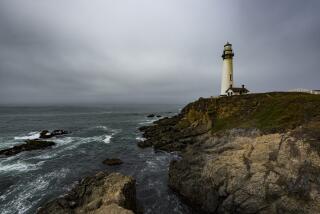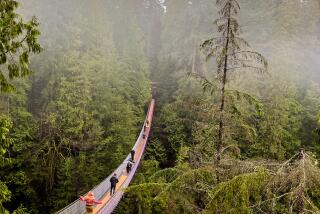Along Expo Route : Obscure House Is a Treasure
- Share via
GOLDENDALE, Wash. — Along the route to Vancouver and Expo 86 are countless special places to visit right in America’s own backyard. One such place is a short detour into a part of Washington not usually seen in travel brochures. It is known for bone gray more than rainbows. But don’t let that stop you.
Surrounded by heat, rattlesnakes and brown hills that see less than nine inches of rain a year, Washington’s arid southeast is an unlikely site for a three-story edifice filled with priceless art and Romanian treasures.
In 1907 Samuel Hill, flamboyant Seattle lawyer, was searching for a Promised Land. He chose the Columbia River Gorge at what is now Goldendale, 100 miles east of Vancouver, Wash. By 1914 Sam had started construction on Maryhill, an elaborate residence dubbed the “Castle on the Columbia.”
But it wasn’t until 1926 that Maryhill’s success was assured, as a museum of art. Its existence can be attributed to an unusual menage a trois of women.
A Stunning Debut
The suggestion for the museum originated with Loie Fuller, known by her adoring public as “La Loie.” In 1892 Loie made a stunning debut in “The Folies Bergere” with her picturesque use of masses of transparent drapery, lighting, and sensuous movements imitating butterflies, flowers and flames. It created a sensation when the lights struck the fluttering, and sheer, material.
Among others, Loie attracted the attention of Toulouse-Lautrec, who did a lithograph of her; Jules Cheret, who did her poster; Rodin, who signed pieces of sculpture “To Loie,” and Queen Marie of Romania, a second of Hill’s triad of women friends.
Queen Marie was indebted to Hill for his aid to devastated Romania following World War I. Perhaps the adage, “All work and no play . . .” attracted her to Sam and his colorful friends. As she loved saying, “I am not a dull boy.”
A favored summer residence of the Queen was Castle Bran, home to Vlad Dracula in the 15th Century. During a celebrated visit to America, Queen Marie dedicated Maryhill Museum to beauty and peace.
A third friend was Alma de Bretteville Spreckels, widow of San Francisco sugar magnate Adolph Spreckels. One never knew what Alma Spreckels might say next, but for certain, she spoke her mind, usually in a booming voice.
She enjoyed claiming relation to Charlotte Corday, mad French aristocrat who stabbed Marat in his bath, and opened many a conversation with, “Got anyone you want murdered?” Alma Spreckels donated time, money and much of what is at Maryhill today.
This unusual trio of women makes Maryhill a memorable experience. Spacious rooms, softened by live plants and natural lighting, exhibit their personal effects, French fashions, icons, Apache baskets and Indian artifacts.
A highlight of the museum is the Queen Marie Room. One display is the newly restored two-piece gold lame and rhinestone gown and train worn by Queen Marie to the coronation of her cousin, Czar Nicholas II of Russia.
The Queen Marie Room also houses royal furniture (including a beautifully crafted, gold-leaf throne), portraits and other memorabilia.
Exhibitions include sculptures by Carrier-Belleuse; exquisite glass creations by Emile Galle; Edwin Howland Blashfield’s painting, “The Musician”; Lord Leighton’s stunning oil, “Solitude,” and Auguste Rodin’s bronze and marble sculptures including “Flore” and the “Vase of the Titans” with its clay working models. His color sketches adorn the walls.
Also on exhibit are striking mementos of Loie. Don’t miss Theodore Riviere’s enchanting bronze harmoniously capturing the flowing gowns and graceful movements of the actress.
“Who in the Sam Hill?” Even though that expression does not refer to Sam, it is apt. Few men could look at the arid hills, ignore vermin and isolation yet envision a “Garden in the Sun.”
Hill, a resplendent gentleman with thick white hair and mustache, loved peace and is responsible for what must be the strangest monument in the Northwest, a full-scale replica of England’s Stonehenge. A mile east of the museum, it honors local World War I casualties. A few steps away is Sam Hill’s simple, stainless steel crypt.
After touring this oasis, munch your lunch upon a manicured lawn or attend a musical concert within Maryhill’s halls while contemplating Sam Hill and his “Castle on the Columbia.”
Maryhill can be reached via Washington 14 east from Vancouver, Wash., or Interstate 84 east from Portland, Ore., about 95 miles, then north on U.S. 97 a few miles. Open March 15 to Nov. 15, daily 9 a.m. to 5 p.m. Admission $2.50 adults, $1 students 6-16. Tours are another $2.
Motels in the area include Ponderosa Motel on U.S. 97; King Motel, King and Court streets, and Home Motel, 702 S. Columbus St. All in Goldendale, Wash. 98620. The Riviera, Nu-Vu (a Friendship Inn) and Dinty’s Motor Inn are in Biggs Junction, Ore. 97050.
You will find camping sites at Maryhill State Park five miles east of the museum or at the Dalles Dam 18 miles west.
Examining Hill’s life is the recently released “Sam Hill, the Prince of Castle Nowhere,” by John E. Tuhy and published by Timber Press ($14.95). Loie’s autobiography, “Fifteen Years of a Dancer’s Life,” is sold exclusively at Maryhill. Hannah Pakula’s new biography of Queen Marie, granddaughter of both Queen Victoria of England and Czar Alexander of Russia, is titled “The Last Romantic,” Simon & Schuster.
Write to Maryhill Museum, 35 Maryhill Museum Drive, Goldendale, Wash. 98620, phone (509) 773-4792.
More to Read
Sign up for The Wild
We’ll help you find the best places to hike, bike and run, as well as the perfect silent spots for meditation and yoga.
You may occasionally receive promotional content from the Los Angeles Times.






